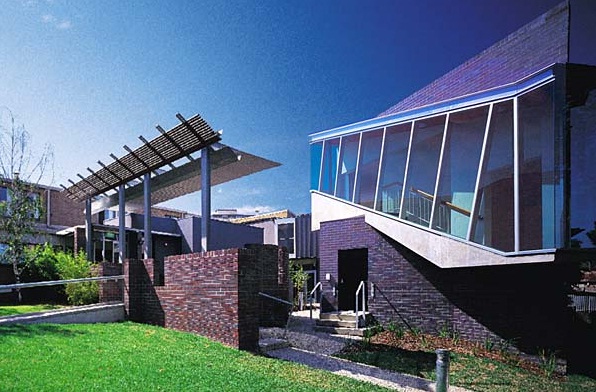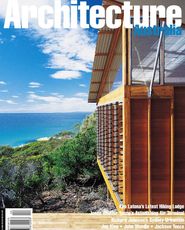
View from the west towards the covered way at left, leading to the entrance, and the new residential wing (with staircase) at right. This project won the sole merit award for multi-unit housing in this year?s RAIA Victorian awards
John Wardle is an architect probably best known for award-winning residences characterised by elegant but elaborately detailed junctions and joinery and careful choices of materials. A less recognised aspect of his practice is its string of low-budget commissions for welfare clients.
His highly successful 1994 design for crisis accommodation for homeless children in Melbourne’s disadvantaged western suburbs resulted from a collaboration between Smorgon Consolidated Industries, the Public Transport Corporation and the Department of Planning and Development, and brought Wardle to the attention of the Salvation Army.
When the Army’s Gill Memorial Home for Homeless Men was to be relocated from the city centre to a redundant 19th century primary school in West Melbourne, where it was renamed the Flagstaff Centre, Wardle’s office was asked to both refurbish the existing buildings and design the new accommodation. Careful attention to the consultation process which preceded the design, and the subsequent success of this commission (programmatically and aesthetically), led to a further assignment to refurbish and extend the Army?s Open Door hostel in North Melbourne, providing short to medium-term accommodation for homeless men.
The Open Door had operated for many years on a busy inner suburban road in a somewhat anonymous, two-storey brown brick building which was ripe for renewal. The existing complex, set well back from the street, was entered through a tiny reception foyer and was most strongly characterised by a recreation-TV room opening to a rustic rear courtyard with a barbecue.
Renewal was a two-stage process. The first phase involved refurbishing upstairs bedrooms and providing new staff offices and reception and interview rooms, and externally adding an entry canopy and a forecourt with seating fixed around the sheltering arc of a high wall.
The architectural intention here was two-fold. Firstly, the previous anonymity of the facility was reversed and a presence on busy Boundary Road was established via the entry canopy. Secondly, the well-known tendency of hostel clients to congregate around the front door or in the reception foyer - observing daily comings and goings - was accommodated by the forecourt seating. Previously, when the recreation room was divorced from front-of-house activities, the residents had tended to gather in the tiny reception foyer. When the constraints of brief and budget ensured that the redesigned foyer remained small (though slightly expanded), it seemed necessary to provide seating in the forecourt.
The second stage of renovations involved adding a new wing with 12 single bedrooms on two levels. Its curved outer wall partially screens the first stage of the development from the busy road and encloses a small courtyard garden between Stage 1 and the inner corridor wall of Stage 2. To serve the new bedrooms, the architects deliberately avoided cost-efficient (but inevitably depressing) double-loaded corridors. Instead, generous windows on the inner wall of a curving corridor give light and views of the courtyard garden.
The outer end of the new wing, closest to the road, is terminated by the inevitable fire stair ? but in this instance, the programmatic necessity has been transformed into an architectural and symbolic asset. The stairwell is within a substantially glazed tower which functions as a beacon and lantern to give The Open Door a positive and hopeful night-time presence in the city.
Inside and out, material choices are direct and robust, as required by the function and inevitably restricted budgets of such commissions. Externally, the palette of black bricks, exposed galvanised steel framing and seamed Colorbond steel cladding express a relationship to the nearby, larger, Flagstaff crisis housing. Internally, finishes are light, bright, low-cost and low-maintenance. Painted concrete block walls and consistent linoleum floors provide a seamless connection between the old and new sections of the facility. According to Jane Barnes, manager of both the Open Door and the Flagstaff Centre, her clients are delighted by their renewed accommodation: especially because it is neither nondescript or anonymous. The Stage 2 accommodation wing radiates freshness and optimism, characteristics not usually associated with such a facility.
Open Door clients are also delighted by the Wardle team’s careful attention to briefings about their needs. They seem to feel that the architects listened carefully and responded well. Buoyed by this renovation experience, Ms Barnes talks enthusiastically of a future when budgets will remove need for multiple sleeping (there are still some double bedrooms in the original building) and permit ensuite bathrooms for every bedroom. She does not see why her clients should be forced to accept accommodation of a standard less than normal for the motels used by most Australians. However, her enthusiasm seems at odds with millennial Melbourne?s almost complete indifference to the simple human needs of our burgeoning population of welfare recipients. Appallingly, the 44-bed Open Door is the only facility of its type: not just in Melbourne but in the whole of Victoria.
In both social and architectural terms, John Wardle Architects can be proud of their achievement here. In a quiet way, this small, social project breaks new ground - and it is to be hoped that sufficient resources can be found in the financially challenged welfare sector to allow further development of what both the architects and Salvation Army see as a new model for crisis accommodation.
Images: Tevor Mein.

New residential wing with the fire exit at left and the cantilevered stair element at right, which lights up like a beacon at night.
 Looking down the stairs of the new residential wing.
Looking down the stairs of the new residential wing.
 The first floor corridor of the new wing, overlooking the central courtyard.
The first floor corridor of the new wing, overlooking the central courtyard.

 View from Boundary Road, North Melbourne.
View from Boundary Road, North Melbourne.
 Detail of new window from the residential staircase.
Detail of new window from the residential staircase.
 A waiting and watching area for residents near the entrance.
A waiting and watching area for residents near the entrance.

Two-tone brick street facade of the new residential wing.
Credits
- Project
- Alterations and additions to the Open Door, North Melbourne, Victoria
- Architect
- Wardle
Melbourne, Vic, Australia
- Project Team
- John Wardle, Maggie Hui, Beatrix Rowe, Chris Idle
- Consultants
-
Builder
Ayton Builders (Stage 1), Van Driel (Stage 2)
Developer Salvation Army
Structural engineer T.D. & C. Pty Ltd
- Site Details
-
Location
Melbourne,
Vic,
Australia
- Project Details
-
Status
Built















